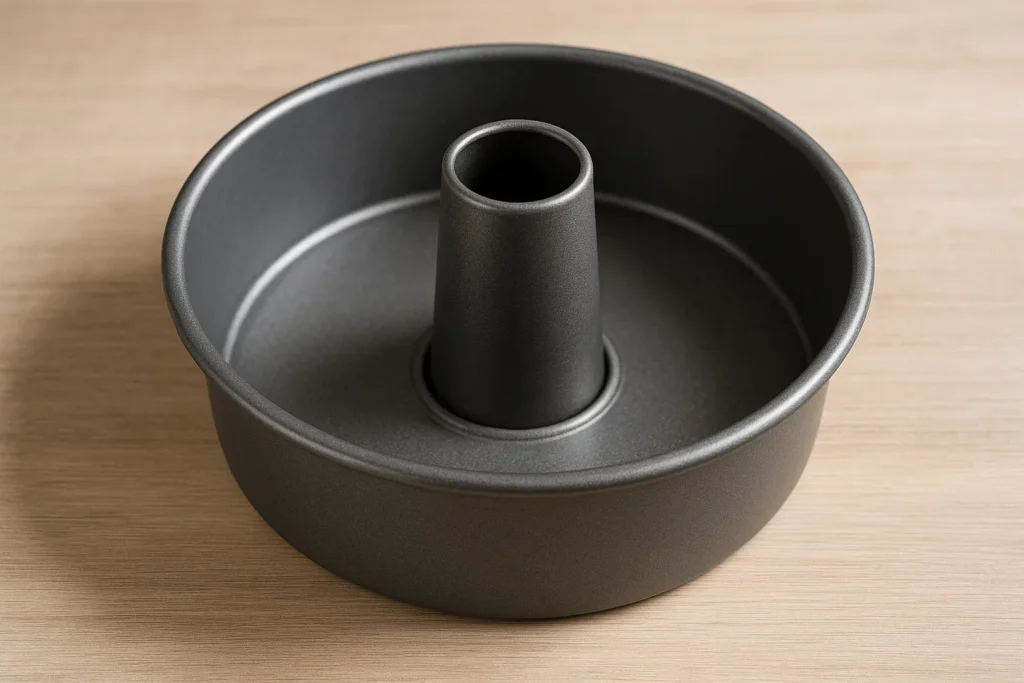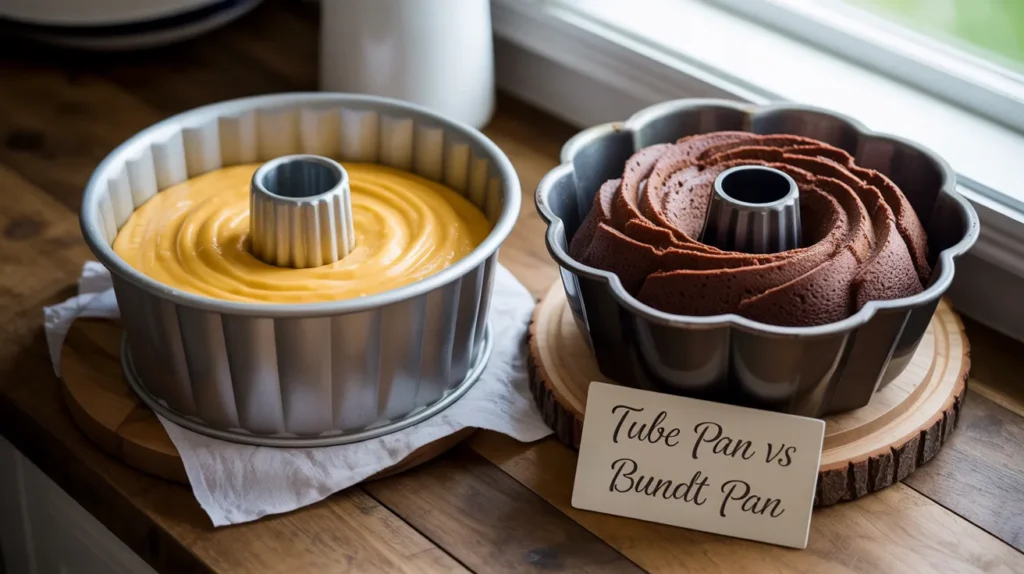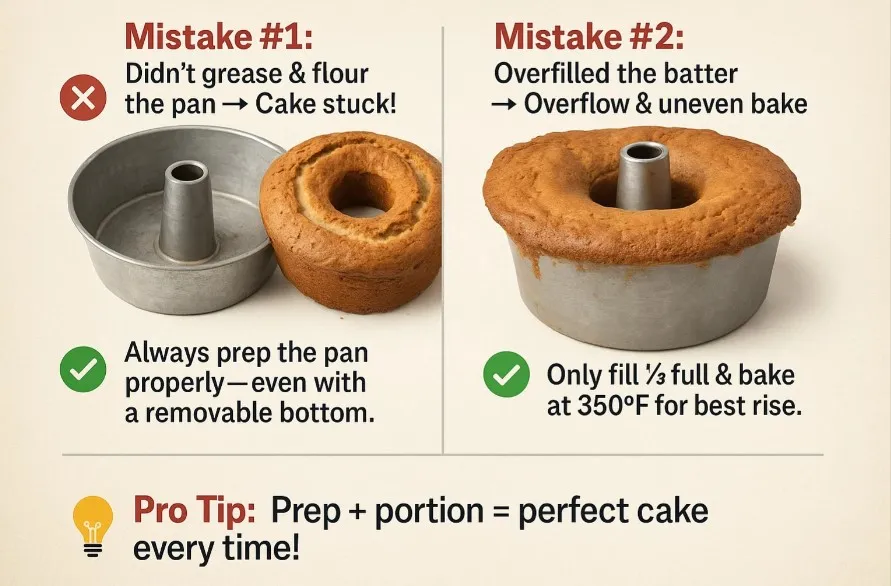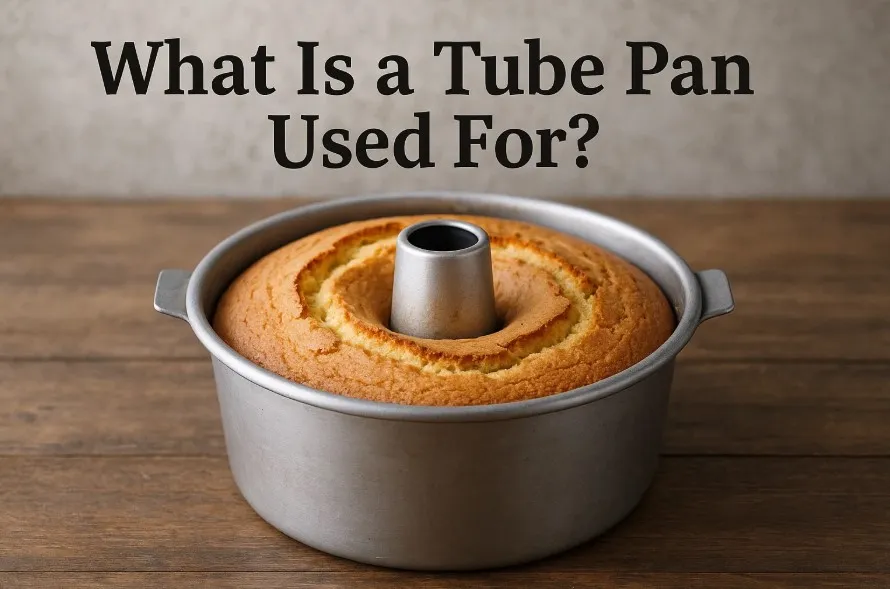A tube pan is designed for baking delicate, tall cakes like angel food or chiffon—its center tube promotes even heat distribution for flawless rise and easy removal!
Let me confess: the first time I saw a tube pan in my grandma’s cupboard, I assumed it was an odd coffee mug holder. Turns out, it’s legendary in the baking world—and not just for angel food cake. But is it as single-purpose as its reputation?
Join me as I tumble through my own triumphs (and lopsided disasters) with the versatile tube pan, uncovering secrets and surprises along the way.

What Makes a Tube Pan Tick?
When people ask about tube pan uses, most think of angel food cake or maybe a classic sponge cake. But there’s a lot more going on with this unique bakeware than just its iconic hole in the middle. Let’s break down what makes a tube pan truly special—and why it’s a staple in my kitchen.
First, let’s talk about the central tube. It’s not just for show. The tube’s main job is to help with heat conduction. By channeling heat right into the center of the batter, the pan ensures your cake bakes evenly from all sides. No more undercooked, gummy middles!
This is especially important for recipes with delicate batters, like angel food cakes and sponge cakes, which need gentle, consistent heat to rise tall and cool properly. Research shows that the central tube is key to preventing those dreaded dense spots that can ruin a light, airy cake.
Another feature I love? The removable bottom, which is common in most tube pans. If you’ve ever tried to wrestle a sticky sponge cake out of a regular pan, you know the struggle. With a tube pan, you can simply push the cake up and out—no flipping, no praying, no broken cakes. I still remember the time I dropped an angel food cake (yes, it happens to the best of us).
The removable bottom saved the day, letting me rescue the cake with minimal damage. It’s a small design tweak, but it makes a world of difference for stress-free cake removal.
Tube pans come in a few variations: some have straight sides, others are fluted. The straight-sided versions are best for recipes where you want the cake to climb and hold its height, like angel food or chiffon cakes. Fluted tube pans, on the other hand, are often used for denser cakes but still benefit from the central tube’s even heat distribution.
“The secret to a perfectly baked sponge cake is all in the pan’s design.” – Mary Berry
So, whether you’re baking a lofty angel food cake or experimenting with new tube pan uses, remember: it’s the pan’s thoughtful design—central tube for heat conduction, removable bottom for easy release—that sets it apart. These features are why tube pans are a favorite for both classic and creative baking adventures.
Tube Pan vs Bundt Pan: Which Cake Goes Where?

When I first started baking, the difference between a tube pan and a bundt pan seemed minor—after all, both have a hole in the center, right? But as I dug deeper into Bundt Pan 101 and experimented with recipes, I realized that choosing the right baking pan can make or break your cake. Let’s break down the essentials of Tube Pan vs Bundt and see where each pan truly shines.
Bundt Pans: The Go-To for Dense Cakes
Bundt pans are famous for their decorative, fluted sides and are built to handle heavier, richer batters. Think pound cakes and coffeecakes—these cakes need a sturdy structure, and the intricate design helps create more surface area for a delicious crust. Research shows that bundt pans are best when you want a cake that’s moist and dense, with a beautiful finish straight from the oven.
Tube Pans: Perfect for Light and Airy Cakes
On the flip side, tube pans have straight sides and are usually uncoated, making them ideal for lighter batters like angel food cakes and chiffon cakes. The central tube helps the cake rise evenly, and the removable bottom makes it easy to release these delicate cakes without damage. Studies indicate that tube pans are a must for egg-white-heavy recipes, where cake expansion and even heat distribution are crucial.
Batter Thickness and Oven Temperature Matter
One thing I learned quickly: batter thickness matters. For fluted tube pans (like bundt pans), the batter should be slightly thicker than for regular cakes—otherwise, you risk a cake puddle instead of a showstopper. And don’t forget oven temperature! Most recipes for both pans call for 350°F, but always check your recipe for specifics, as the details can affect rise and crumb.
“Always check your recipe before subbing pans; results are more dramatic than you think.” – Rose Levy Beranbaum
Here’s a quick comparison to help you decide:
| Pan TypeBest ForBatter ConsistencyCommon Oven Temp | |||
|---|---|---|---|
| Bundt Pan | Pound cakes, coffeecakes | Thicker | 350°F |
| Tube Pan | Angel food cakes, sponge cakes | Lighter/airier | 350°F |
While both pans have a central tube, their uses aren’t interchangeable. Batter consistency, pan type, and oven temperature all play a big role in baking success.
Beyond Angel Food: Surprising Tube Pan Applications
When most people think of tube pan uses, angel food cake is probably the first thing that comes to mind. But honestly, that’s just the beginning. Over the years, I’ve found that tube pans are some of the most versatile tools in my kitchen. Their unique design—with a central tube and often a removable bottom—makes them perfect for more than just classic sponge cakes.
Let’s start with the obvious: sponge cakes and chiffon cakes. The tube pan’s shape allows for even heat distribution, which is essential for these airy batters. The central tube helps the cake rise high and bake evenly, while the removable bottom makes cake removal a breeze. But don’t stop there. If you love experimenting with cake recipes, you’ll be happy to know that tube pans can handle much more.

Have you ever tried making an ice cream cake base in a tube pan? It’s a game-changer. The pan’s structure supports layered ice cream, and the removable bottom makes it easy to pop out the finished dessert. And if you’re feeling adventurous, tube pans can double as molds for savory bakes.
I once made a cornbread ring and even a loaded mac-and-cheese “cake” in mine—both were hits at family gatherings. The most surprising experiment? A deep-dish pizza ring. The family’s verdict: “Odd but oddly delicious.”
Research shows that tube pans excel at both traditional and experimental baking projects. Their variety in pan sizes—9-inch and 10-inch are most common—offers flexibility for different cake recipes. Just remember, cake expansion is real. Always leave a little room at the top for your batter to grow. This is especially important for sponge cakes, which need space to rise without overflowing.
“Baking sometimes means breaking the rules. Who says a tube pan can’t do it all?” – Dorie Greenspan
Here’s a quick look at tube pan versatility:
| Feature | Details |
|---|---|
| Common Pan Sizes | 9-in, 10-in |
| Cake Expansion | Leave room at the top for rising |
| Unconventional Recipes | Ice cream cakes, savory bakes (cornbread, mac-and-cheese, pizza ring) |
| Cake Removal | Removable bottom for easy release |
A tube pan isn’t just for dessert. Try it for creative cake shapes, layered ice cream, or savory bakes. Just remember to leave space for cake expansion and use the right size!
Tube Pan Mishaps and Successes: What I Learned the Hard Way
When I first started experimenting with tube pans, I thought their use was pretty straightforward—mainly for angel food cakes and maybe the occasional sponge. But as I quickly learned, the real lessons come from the mishaps. And trust me, I’ve had my share.
One of my earliest mistakes was skipping the crucial step of greasing and flouring the pan. I figured, “How bad could it be?” Well, the answer: disastrous. My cake glued itself to the pan in a stubborn rebellion, refusing to budge even with the gentlest coaxing.
Research shows that proper pan preparation—especially with tube pans—is essential for successful cake removal. The removable bottom is a great feature, but it’s not magic. Without a well-greased and floured surface, even the best Baking Techniques can’t save you from a cake that’s stuck fast.

Another lesson came from underestimating the importance of oven temperature and batter levels. I once overfilled the pan, thinking I’d get a taller cake. Instead, I ended up with a lopsided mess that spilled over the sides and baked unevenly.
Studies indicate that oven temperature directly impacts cake rise and crumb, while leaving enough space for Cake Expansion is critical. Most tube pan recipes recommend filling the pan only two-thirds full and baking at 350°F for the best results. It’s a simple rule, but easy to overlook in the excitement of baking.
And then there was the time my neighbor borrowed my tube pan for meatloaf. I was skeptical—tube pans are for cakes, right? But the result was surprisingly great. The central tube helped the meatloaf cook evenly, and it popped right out after a quick run around the edge with a knife. That experience opened my eyes to the versatility of tube pans. They’re not just for sweets; savory experiments are encouraged and can be just as successful.
Looking back, I realize that my biggest baking wins have often come from my biggest flops. As Julia Child once said,
“Your best baking teacher is often your biggest flop.”
If there’s one thing I’ve learned, it’s that mastering Baking Techniques, understanding Oven Temperature, and respecting Cake Expansion are all part of the journey. And sometimes, the best discoveries happen by accident.
Frequently Asked Questions For What Is a Tube Pan Used For?
Can I use a regular pan instead of a tube pan?
For some cakes, yes, but recipes like angel food cake require a tube pan for proper rising.
Do I need to flour a tube pan?
It depends on the recipe. Dense cakes like pound cake benefit from flouring, while light cakes like chiffon don’t.
Can I make a bundt cake in a tube pan?
Yes, but the design won’t be as decorative. A bundt pan is better for intricate shapes.
Best Tube Pans to Buy
Here are some top picks:
- Nordic Ware Angel Food Cake Pan – Durable and non-stick.
- Fat Daddio’s Anodized Aluminum Pan – Even heating, great for professional bakers.
- Wilton Recipe Right Tube Pan – Affordable and reliable.
“Baking is science, but the right tools make it feel like magic.” — Alton Brown
Easy Tube Pan Recipes
Classic Angel Food Cake
- Ingredients: Egg whites, sugar, flour, cream of tartar.
- Method: Whip egg whites to stiff peaks, fold in dry ingredients, bake in an ungreased tube pan.
Lemon Pound Cake
- Ingredients: Butter, sugar, eggs, flour, lemon zest.
- Method: Cream butter and sugar, add eggs, then dry ingredients. Bake in a greased tube pan.
Conclusion
Now you know what a tube pan is used for—it’s perfect for angel food cake, bundt cakes, and more. Its unique design ensures even baking and great results. Whether you’re a beginner or a pro, a tube pan is a must-have for your kitchen.
Ready to bake? Grab a tube pan and try a recipe today!

